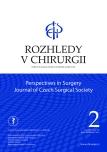Robotic pyeloplasty in children – a pilot study
Authors:
J. Trachta; B. Kučerová; M. Rygl
Authors‘ workplace:
Klinika dětské chirurgie, 2. lékařská fakulta Univerzity Karlovy a Fakultní nemocnice v Motole, Praha
Published in:
Rozhl. Chir., 2022, roč. 101, č. 2, s. 79-84.
Category:
Original articles
doi:
https://doi.org/10.33699/PIS.2022.101.2.79–84
Overview
Introduction: Pyeloplasty for congenital hydronephrosis (pyeloureteral junction obstruction, PUJO) can be performed as an open, laparoscopic or robotic procedure in children. The aim of this study was to analyze a pilot cohort of pediatric patients operated robotically.
Methods: A retrospective analysis of the cohort of patients 3 to 18 years of age who underwent primary robotic pyeloplasty between December 2018 (which is when the robotic program was launched at the University Hospital Motol) and June 2021. Patients already operated on for PUJO in the past were excluded. The indication criteria, clinical symptoms, operation time, hospitalization length and complications were evaluated from the medical records.
Results: During this period, we operated on 28 children aged 3 to 17 years (median 8); 2 patients were excluded. Of the 26 children analyzed, 6 (23%) were asymptomatic before surgery, 17 (65%) reported pain, 2 (8%) had acute pyelonephritis before the surgery, and 1 (4%) suffered from nephrogenic hypertension. The most common etiology of PUJO was an aberrant vessel in 22 (85%) patients. The time from incision to skin closure was 106 to 201 minutes (median 142 minutes). Patients were hospitalized for 3 to 5 days (median 4) after the surgery and followed up for 1 to 30 months (median 6). Twenty-four of the 26 patients showed regression of the pelvic dilatation according to the postoperative ultrasound scan and no symptoms of PUJO. Seven (27%) had postoperative complications requiring a procedure under general anesthesia (all Clavien-Dindo 3b); of these, 2 were re-operated.
Conclusion: Robotic pyeloplasty is an alternative to laparoscopic and open surgery. It is a safe and successful (92%) method. We believe that the higher rate of complications (27%) in our cohort is due to the fact that this is a new technique and more experience is needed.
Keywords:
hydronephrosis – child – postoperative complication – robot-assisted surgery – pyeloplasty
Sources
1. Anderson JC, Hynes W. Retrocaval ureter; a case diagnosed pre-operatively and treated successfully by a plastic operation. Br J Urol. 1949;21(3):209–214.
2. Hanuš T, Macek P, et al. Urologie pro mediky. Univerzita Karlova v Praze, Nakladatelství Karolinum 2015:180.
3. Reismann M, Gratz KF, Metzelder M, et al. Excision of the dilated pelvis is not necessary in laparoscopic dismembered pyeloplasty. Eur J Pediatr Surg. 2008 Feb;18(1):19– 21. doi:10.1055/s-2007-989298. PMID: 18302064.
4. Morales-López RA, Pérez-Marchán M, Pérez Brayfield M. Current concepts in pediatric robotic assisted pyeloplasty. Front Pediatr. 2019 Jan 24;7:4. doi:10.3389/ fped.2019.00004. PMID: 30733937; PMCID: PMC6353791.
5. Meininger D, Byhahn C, Markus BH, et al. Total endoscopic Nissen fundoplication with the robotic device „da Vinci“ in children. Hemodynamics, gas exchange, and anesthetic management. [Article in German] Anaesthesist 2001 Apr;50(4):271– 275. doi:10.1007/s001010051001. PMID: 11355424.
6. Cundy TP, Shetty K, Clark J, et al. The first decade of robotic surgery in children. J Pediatr Surg. 2013 Apr;48(4):858–865. doi:10.1016/j.jpedsurg.2013.01.031. PMID: 23583146.
7. ESPU Annual Congress 2019, Lyon, John Duckett Lecture: Yves Heloury (Australia): Minimally invasive surgery in paediatric urology after Trump.
8. McCann ME, Soriano SG. Does general anesthesia affect neurodevelopment in infants and children? BMJ. 2019 Dec 9;367:l6459. doi:10.1136/bmj.l6459. PMID: 31818811.
9. Mixa V. Neurotoxicita anestetik a dozrávající dětský mozek. Anest intenziv Med. 2017;28:282–286.
10. Dindo D, Demartines N, Clavien PA. Classification of surgical complications: a new proposal with evaluation in a cohort of 6336 patients and results of a survey. Ann Surg. 2004 Aug;240(2):205–213. doi:10.1097/01.sla.0000133083.54934.ae. PMID: 15273542; PMCID: PMC1360123.
11. Andolfi C, Adamic B, Oommen J, et al. Robot-assisted laparoscopic pyeloplasty in infants and children: is it superior to conventional laparoscopy? World J Urol. 2020 Aug;38(8):1827–1833. doi:10.1007/ s00345-019-02943-z. Epub 2019 Sep 10. PMID: 31506749.
12. Trachta J, Pýchová M, Zeman L, et al. Přínos dynamické scintigrafie v pooperačním sledování pacientů po pyeloplastice pro jednostrannou obstrukci pyeloureterálního přechodu. Ces Urol. 2017,21(3):217–224. Available at: https:// www.czechurol.cz/pdfs/cur/2017/03/03. pdf.
13. Morales-López RA, Pérez-Marchán M, Pérez Brayfield M. Current concepts in pediatric robotic assisted pyeloplasty. Front Pediatr. 2019 Jan 24;7:4. doi:10.3389/ fped.2019.00004. PMID: 30733937; PMCID: PMC6353791.
14. Silay MS, Spinoit AF, Undre S, et al. Global minimally invasive pyeloplasty study in children: Results from the Pediatric Urology Expert Group of the European Association of Urology Young Academic Urologists working party. J Pediatr Urol. 2016 Aug;12(4):229.e1−7. doi:10.1016/j. jpurol.2016.04.007. Epub 2016 May 12. PMID: 27346071.
Labels
Surgery Orthopaedics Trauma surgeryArticle was published in
Perspectives in Surgery

2022 Issue 2
Most read in this issue
- Conservative versus surgical treatment of displaced midshaft clavicle fracture in adolescents
- Retrospective analysis of necrotizing pneumonia in children between 2015–2019
- Robotic pyeloplasty in children – a pilot study
- Initial experience with single incision laparoscopic appendectomy
